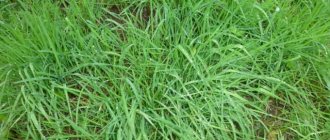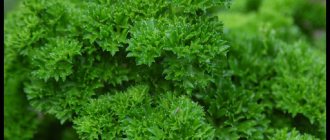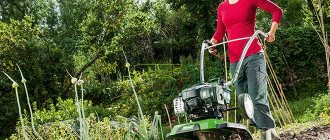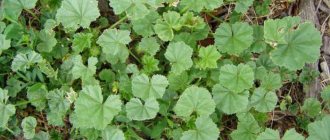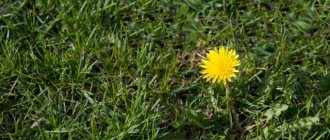Weeds can survive in any difficult conditions. It is almost impossible to remove them completely. Weed control in beds or flower beds is much easier than on lawns. Most fruiting crops are not planted close to each other; there is always free space between them, which makes it easier to destroy weeds. It is difficult to carry out such a procedure on lawns, since the lawn grass will also suffer, and the appearance of individual bald spots on the body of the lawn does not look aesthetically pleasing, to put it mildly. There is only one way out in this situation - gardeners need grass for the lawn, which displaces weeds.
How to care for your lawn without weeds
A lawn that is properly cared for can resist weeds and “repel enemies.” If the lawn is dense and good, weed seeds from unkempt neighboring plots practically do not take root on it. Therefore, our experts always emphasize in their comments: herbicides are not a panacea; first you need to establish nutrition, mowing and watering regimes, and only then resort to the help of the chemical industry.
Sodmaster Consultant FORUMHOUSE, Moscow.
Killing weeds is not a problem, the problem is to grow a lawn in the free space...
An integrated approach to weed control in the lawn should include the following:
- we always feed the lawn in a timely manner (by the way, nitrogen fertilizers are excellent against weeds such as clover);
- We always water the lawn on time to prevent drought-resistant weeds from taking over non-drought-resistant lawn grass;
- From spring to autumn we do not miss mowing the lawn, because by over-growing the lawn and then cutting it almost bald, we greatly weaken it.
Let's look at it with an example.
Here is a set of specific measures that FORUMHOUSE expert Lawnmower advised to our portal participant Rosita to combat her “unhappy lawn”:
- Water it, even take a leak. In the center of the lawn, in the sun, where the grass has clearly dried out, give 20-25 liters per square meter. m, and in the shade around the edges it can be less.
- Wait a day or two and feed with half a dose of complex fertilizer. If you don’t have a complex fertilizer, you can simply feed it with nitrogen alone (250 g/area per hour) and water it a little more.
- Wait a couple more days and mow; for this particular case, the expert recommends setting the mower to 6 cm.
LawnmowerAgronomist, member of FORUMHOUSE
Then the carousel will spin: mow more often, but do not lower the height until everything reaches the same height. Watering a week later, but abundantly, two weeks after the first feeding, the second (complex (3-1-2), 250 g/acre for nitrogen).
Another example: the next year after sowing, alexey_og's lawn caused horror; it seemed that the lawn consisted of only weeds, that only weeds grew on the lawn. This lawn has been revived with weekly mowing, regular watering and fertilizing. The result of this work was not long in coming!
alexey_og FORUMHOUSE Member
In just 1.5 months, my bluegrass lawn begins to put pressure on the weed, and judging by the mood of the development of meadow bluegrass, it will gradually crush it. Hopefully the lawn will be great by next year.
The bluegrass develops slowly, at the first stage it lags far behind the rapidly growing weed. But with proper care, the balance of forces will certainly change. Don't rush with herbicides!
Types of green manure
There are more than 400 species of green manure crops. The most effective are legumes, cruciferous plants, cereals and some decorative flowers.
Legumes
It is better to sow such plants in marshy and clayey soils. They reduce acidity, improve phosphorus absorption and enrich the soil with nitrogen. Legumes can be sown up to 3 times a season.
- Sweet clover is optimal for saline soils; it is sown in summer and left until winter; it must be mowed in spring. The plant helps against wireworms.
- Espacert is suitable for any soil and grows well even on rocky soil. With long roots it drains the soil 10 m down and is sown in a fallow area.
- Broad beans are very effective, they are unpretentious, have high nutritional value, and are excellent for heavy soils lacking humus.
- Peas are suitable for neutral soil, with accelerated growth they actively fight weeds and are planted in August.
- Vetch grows very quickly, perfectly improves the soil structure, is sown in early spring and cut after 2 weeks. Well suited for tomato beds.
- Lupine is optimal for uncultivated land. The plant is able to bring useful elements to the surface for subsequent crops due to its powerful root. After it, it is better to plant this place with zucchini, grapes or strawberries.
- Alfalfa is a perennial grass for neutral soils with moderate moisture. It effectively increases fertility. The plant must be harvested before budding.
Cruciferous
- White mustard is optimal for heavy soils; it kills late blight, scab and rot. It is not tolerated by the pea moth, wireworm and slug. The plant enriches the soil with sulfur, phosphorus and nitrogen. The crop is sown from mid-April to mid-August at 7 g per square. It is an excellent precursor for tomatoes, cucumbers, potatoes and peppers.
- Rapeseed is resistant to spring cold, quickly gains weight, and perfectly loosens the soil. It is planted at the end of August before winter. The culture is good for black soil, sandstone and loam.
- Oilseed radish is not afraid of drought and low temperatures. It will kill the wheatgrass. Adapts well to any soil.
- The rapeseed loves moist soil, it is planted even in September and mowed before the cold weather.
Cereals
Cereals perfectly rid the area of weeds and efficiently fertilize the soil. The most productive members of the family:
- Oats are best grown in acidic soil. The roots of the culture provide phytosanitary prevention against rot and wireworms. Sow in early spring, cut before flowering. Enriches the soil with potassium and is optimal for preparing beds for nightshades.
- Rye is used as a winter crop; it destroys pathogenic microflora. The green mass is mowed in the spring before planting the garden.
- Barley is resistant to drought and cold. It is sown after the snow melts and cut after 45 days.
- Buckwheat rids the soil of wheatgrass, saturating it with potassium and phosphorus. It can be planted in spring and before winter. The seedlings must be removed before the flowers appear.
Decorative
Flower crops can be used as green manure:
- Phacelia is unpretentious to the soil, resistant to drought and cold, and is sown from April to September. Helps in the fight against nematodes, enhances the effect of legumes.
- Amaranth loves warmth, is planted after harvesting early vegetables, and mowed before budding. Suitable for any soil, improves soil structure and composition, and has phytosanitary properties.
- Calendula is an excellent “neighbor” for nightshades. It heals the soil and is effective against the Colorado potato beetle and wireworm. Sowing is done in August, and the plantings are cut in October.
How to care for a young lawn
We use herbicides as a last resort. This rule is especially important for young grass, which is also susceptible to chemicals. And if you are just creating a lawn, then at the first stage you are ready to get a lawn made of weeds: weeds will come out of the soil earlier than grass.
The fact is that a young lawn suffers from annual weeds, and they can be easily dealt with by simple mowing; nothing else is needed.
LawnmowerAgronomist, member of FORUMHOUSE
Regular mowing gets rid of almost all weeds, and even gets rid of annuals at once.
After about the third mowing, when the grass begins to thicken, selective herbicides can be used to control perennial weeds. As a rule, there are two types of such herbicides on sale: Lontrel 300 and Lintur .
SodmasterFORUMHOUSE Consultant
But even better is a mixture of both.
Selective herbicides kill only dicotyledonous plants.
Nuances in weed control methods
Mechanical removal (depletion)
Pulling out weeds by hand or with special tools, regularly cutting them at the root, destroying stems before flowering. The method is the most labor-intensive, because this procedure must be carried out frequently and very carefully. The method takes a lot of effort and time, but it has been tested for decades and is the safest for cultivated plants.
Biological method (mulching)
Darkening the ground with any material that does not transmit light. Lack of lighting suppresses plant growth and leads to the death of the weed root system. Thoroughly dried compost, tree bark, sawdust or special mulching fiber are suitable for this purpose. The method is not too labor-intensive, but it will not be possible to achieve immediate results; it will take at least two seasons to completely destroy weeds.
Chemical method (herbicide treatment)
The fastest way to get rid of weeds in the garden is to spray them with chemicals (like Roundup), which we purchase at the appropriate stores. In advanced cases, this is the only way to completely destroy harmful plants.
When choosing this method, it is important to remember that the chemicals are highly toxic and can harm beneficial plants. It is recommended to use herbicides outside the garden or at the end of the summer season, after harvesting.
Weeds dry out, deplete the soil, some of their species release toxic substances (phytoncides) into the soil, grow everywhere, and there is no universal method of combating them. Only the integrated use of all protection methods will help rid gardens and summer cottages of green “invaders.” Even though gardeners’ fight against weed pests requires special efforts, the result will definitely justify them if you are not lazy and fight weeds in a timely manner.
Selective herbicides
Selective herbicides work differently than Roundup. Weeds treated with Roundup stop being green and turn yellow. When exposed to selective herbicides, they lose their shine, stop growing (a “twisting effect” is often observed) and dry out.
These herbicides should not be allowed to affect cultivated flowers, vegetables, etc. – this will lead to the death of these plants. Therefore, it is better not to plant flowers in the middle of the lawn, and when treating the lawn with herbicides, use maximum caution on your territory.
One more point: it is not recommended to mow the lawn low immediately after treatment, or mow more than two centimeters. If before treatment the mowing height was 4-6 cm, it should remain the same after treatment.
When using herbicides for the first time, our experts advise following the instructions on the package to avoid problems with concentration. For subsequent treatments, it is better to follow the instructions specified in the reference book.
SodmasterFORUMHOUSE Consultant
The actual concentrations are indicated there, and on the packaging for “dummies” - taking into account reinsurance.
When killing weeds, it is not the quantity of herbicides that is important, but their concentration.
SodmasterFORUMHOUSE Consultant
Regarding con, it is indicated: lintur for lawns 0.18 kg per hectare. This means that 180 g must be diluted in 250 liters (average consumption of working fluid per hectare). And for personal use it says 1.8 g per 5 liters of water. That is, the concentration is reduced by half.
Under no circumstances should you get carried away with herbicides and carry out additional treatments for greater efficiency, and if you have treated your lawn and there is no effect, talk to specialists. You can ask questions related to weeds in your lawn to FORUMHOUSE experts and members.
Apply herbicides only when you are sure it is necessary.
When and how to use herbicides
There are situations in which herbicides have no effect on weeds. This happens in several cases:
- after flowering (when seeds begin to set),
- in dry sunny weather,
- on cold days.
Based on this, experts consider the best periods for using these substances to be the end of May - the beginning of June and the end of August.
To enhance the effect of herbicides, it is necessary to prepare before applying them: the lawn must be fed and watered properly. On a well-maintained lawn, herbicides work like a magic wand.
Here's an example: clover is a weed that is “starved”, without fertilizing, and is highly resistant to herbicides. It cannot be destroyed without feeding, so the FORUMHOUSE Lawn Mower consultant recommends the following algorithm to combat this weed: feeding - watering - treatment after two days.
Clover is perfectly destroyed by preparations containing 2,4D, but such preparations, approved for use in private household plots, are not commercially available in most post-Soviet countries. Our expert suggests a mixture of Lintur and Lontrel.
Lawnmower Agronomist, member of FORUMHOUSE
Remember, in the tank mixture the concentration should be reduced by 10-30%, so if you stir, then within the limits indicated, and first dissolve the lintur in a separate container.
And now, to talk about the influence of proper agricultural technology on the effectiveness of herbicides: a member of our portal, Yuriych, bred clover with one herbicide (one and a half bags per 5 liters).
YuriychFORUMHOUSE Member
The third year without clover, and not only without it!
In the photographs below you can compare the same plot, before and after herbicide treatment, with and without clover; but in both photos we see a lawn that has been carefully maintained.
Orhidika Member of FORUMHOUSE
Super example - what to do to have a good lawn...
Another example is from a member of our portal Just a grandfather talks about an area on his lawn where dandelions don’t even encroach, and where moles don’t even try to dig holes. This lawn is eight years old, and the red fescue, which has been well looked after, in this case acted as a weed-killing lawn grass: it replaced the dandelions!
There is no point in looking for special grass for the lawn that displaces weeds - with proper care and regular mowing, any grass will displace weeds.
Rhizomatous grasses crowd out dandelions, especially if they receive support in the form of mowing and fertilizing.
SodmasterFORUMHOUSE Consultant
My standards are generally wild - four weeds per acre are allowed on the lawn. And nothing happens.
Regular, heartfelt feeding helps to meet “wild standards”, thanks to which weeds cannot compete with lawn grass, and mowing twice a week.
Why didn't the herbicide help?
After treating the lawn with a herbicide, nothing may happen to the weeds at all; they will continue to brazenly stick out from the lawn grass. Here's why this could happen:
- you carried out the treatment in inappropriate weather, on a drought or rainy day, on a windy, cold or hot day;
- there are weeds that are resistant to herbicides;
- low concentration or defective batch of herbicide;
- the weeds recovered from their dormant rhizomes so quickly that it seemed like the herbicide had no effect.
Each case must be dealt with individually, with the help of an agronomist.
Soil preparation
Once the area is prepared, you will need to tackle the soil. It is necessary to add manure or humus to clay soil. If your site has high acidity, then it should be limed. In early spring, you can add nitrogen fertilizers to the soil to stimulate plant growth. Closer to autumn, mineral fertilizers. After this, the soil will need to be loosened and leveled. And then water and start planting lawn grass. It is important to note that lawn grass can be planted from early spring to late autumn. However, it is best to do this either in spring or autumn, so that the grass can winter well and become stronger. If you decide to plant lawn grass in the fall, make sure that the first shoots appear before the onset of frost. If you want to sow lawn grass evenly, you will need a special seeder. After you have scattered the seeds, you should level the soil and roll the area.
